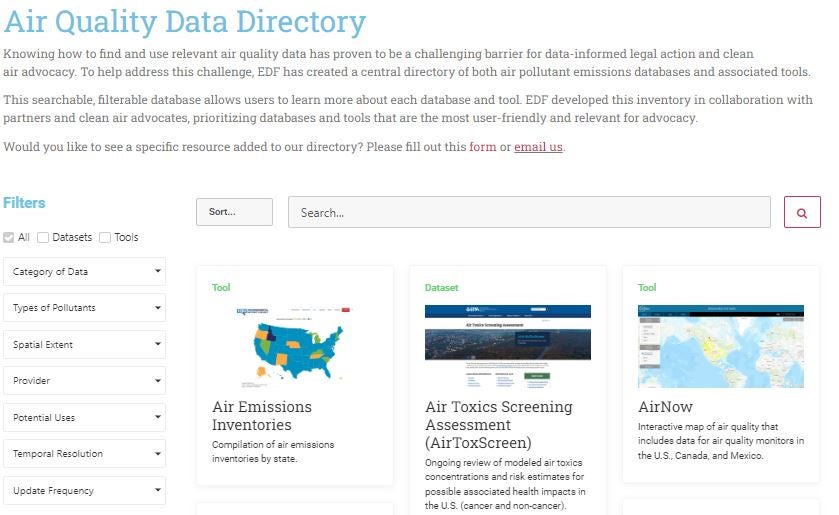
By Adrienne Parks, Analyst, Community Engagement
What’s new: A new tool from Environmental Defense Fund and partners is making it easier to connect clean air advocates with data to drive action. The Air Quality Data Directory is a filterable and searchable database of air pollution emissions datasets and associated tools intended to help demystify the process of finding and using relevant air quality data.
Why it matters: Air quality data is a powerful tool for driving change and validating communities’ lived experiences with pollution exposure. However, it isn’t always clear which datasets best answer specific questions or what data the public can access.
This data directory is a central hub that can help orient users to the world of air emissions datasets and tools. By applying filters to narrow down the many available datasets, advocates can identify which data source(s) can help advance a goal or solve a problem.
The aim of the directory is to help get the right data into the hands of advocates working to protect our health and climate. See below for an example of how a community-based organization in Texas uses databases that are found in our directory to inform and amplify their advocacy.
Data in Action – Air Alliance Houston’s AirMail Tool: Air Alliance Houston (AAH) is an advocacy organization working to reduce the health impacts of air pollution and advance environmental justice in the Houston area. AAH developed AirMail, a permit-tracking tool designed to help advocates monitor and take action on polluter permit notices in their communities.
What does AirMail do? AirMail tracks industrial permits as soon as they are submitted to the state regulator and triggers bilingual direct-mail campaigns to notify local residents. The tool helps fill gaps in the state’s community engagement efforts by calling attention to industrial polluters’ plans to expand operations.
What data does AirMail use? AAH developed a prioritization process that determines which permits AirMail focuses on by pulling in several datasets on air emissions: EPA data on facility-level greenhouse gas emissions, releases of toxic chemicals, modeled risk from toxic chemicals, facility compliance with environmental laws and more.
In addition to prioritizing facilities based on these datasets, AAH included qualitative data not already captured. It answered questions like:
- Has a facility’s pollution caused well-publicized harms to a community?
- Has it been in the news for fires, accidents, or other disasters? and
- Are people paying attention to the health risks of added pollution?
How does AirMail inform advocacy? AirMail automatically generates postcards notifying residents of the potential pollution harms—and ways they can take action. Examples of these include submitting public comments and contacting state representatives to request a public meeting.
What’s next: EDF and partners will continue to build out this directory as new datasets and tools come online. If you’d like to see a specific resource added to our list, please reach out via this form or by email.
We would like to thank our partners and contributors who helped put this resource together. We could not have done it without your helpful feedback and advice along the way.
- Air Alliance Houston
- Tulane Environmental Law Clinic
- The Data Center
- WE ACT for Environmental Justice
- The Climate Reality Project
- Rocky Mountain Institute
- Beyond Petrochemicals
- Earthjustice
- Healthy Gulf
- Environment Texas
- Environmental Integrity Project
